Abstract
The effect of pyrimidine photodimers on transmethylation reactions catalyzed by a highly purified rat liver DNA (cytosine-5-)-methyltransferase (EC 2.1.1.37) that exhibits maintenance and de novo methylation activities was studied in vitro, using the viral substrates M13 mp9 replicative form (RF) DNA and the hemimethylated analog formed from primed synthesis of phage DNA in the presence of 2'-deoxy-5-methylcytidine 5'-triphosphate. These DNAs were irradiated with UVB (280-340 nm) at 900-3600 J/m2 in the presence of the triplet-state sensitizers acetone or 3-dimethylaminopropiophenone. Under these conditions of irradiation, which approximate solar UV, pyrimidine cyclobutane photodimers were introduced without producing any evidence of single-strand breaks or alkali-sensitive sites [i.e., no (6-4)pyrimidine-pyrimidone photoproducts]. This was confirmed by gel analysis, a T4 UV endonuclease nicking assay specific for cyclobutane-type dimers, and HPLC analysis of the photoproducts. The methylation of irradiated templates by DNA methyltransferase was inhibited in an approximately linear fashion as a function of increasing UVB dose. This inhibition was correlated with the number of lethal photoproducts detected by the simultaneous measurement of the surviving fraction of infectious phage DNA. For approximately the same number of pyrimidine cyclobutane photoproducts introduced, de novo methylation activity was approximately 2-fold more sensitive than the maintenance mode of methylation. The ability of these putatively carcinogenic, pyrimidine photoproducts to inhibit DNA methylation suggests a common mechanism of action with several chemical carcinogens that are known to modify bases.
Full text
PDF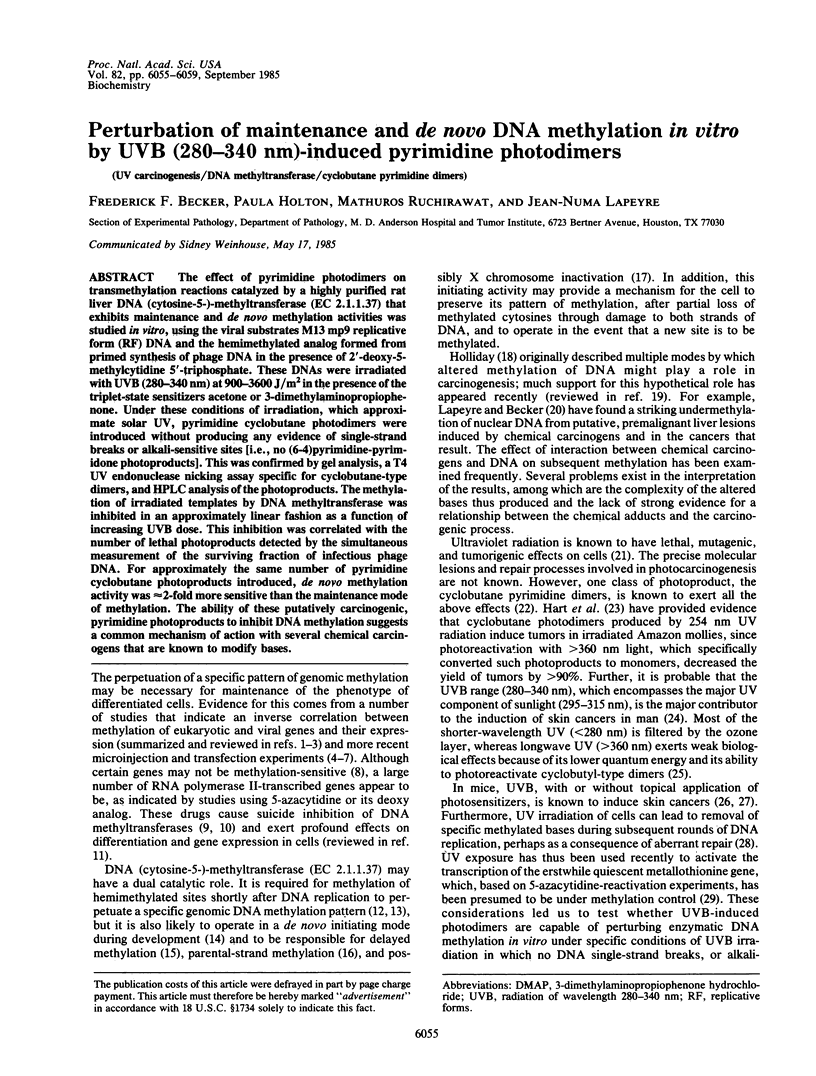
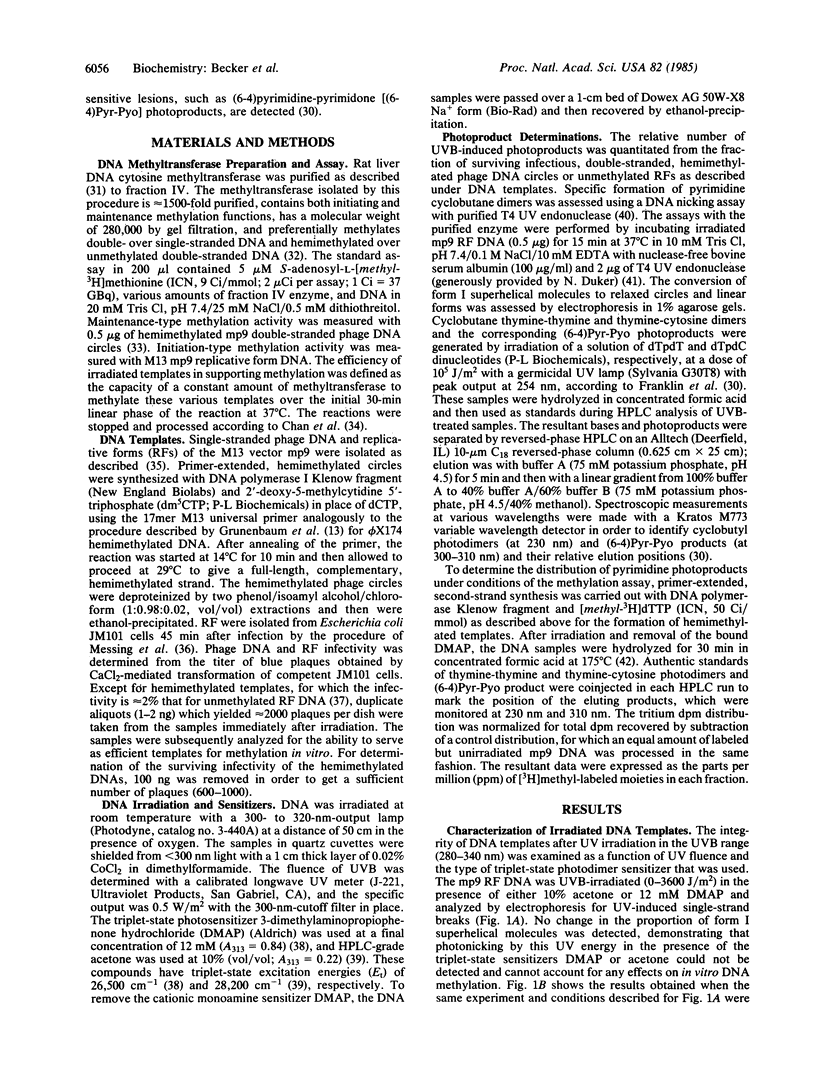
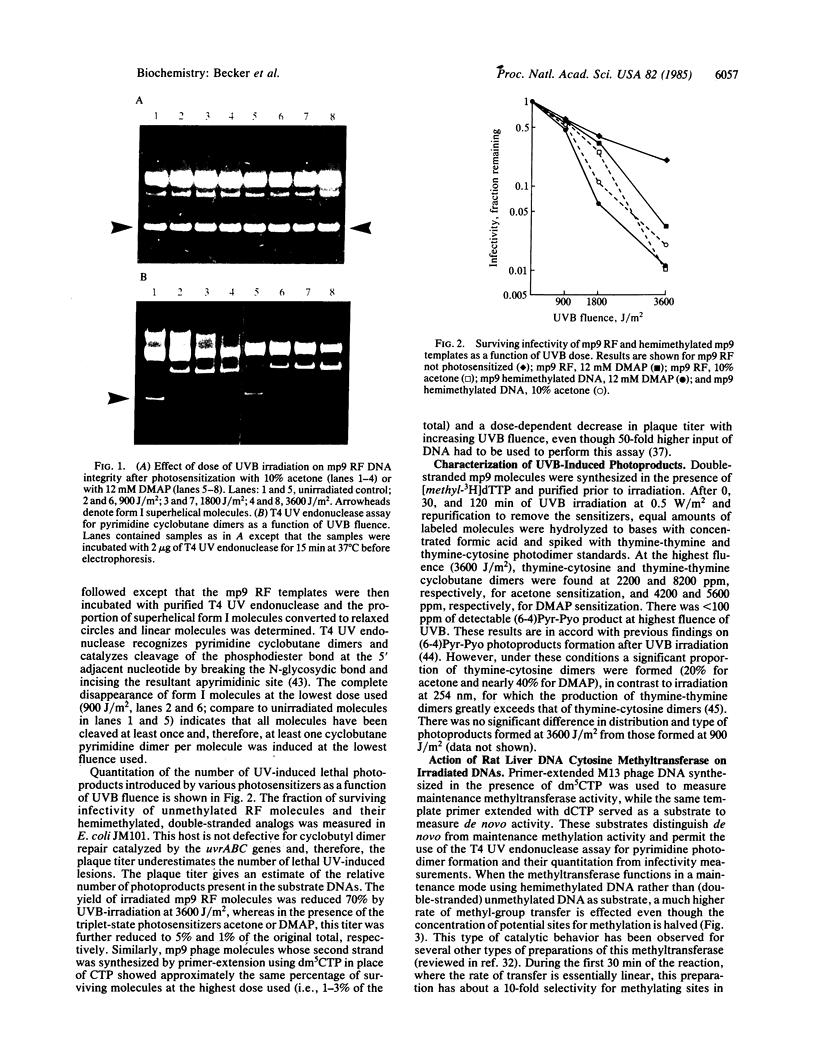
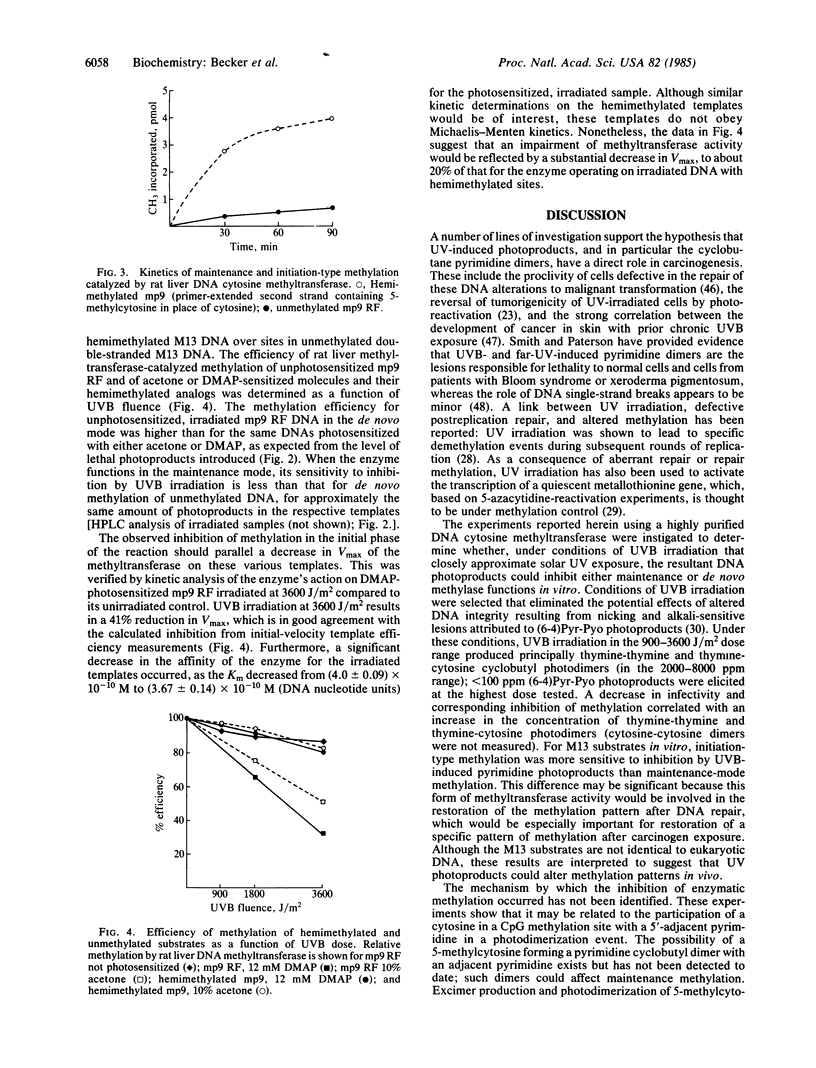
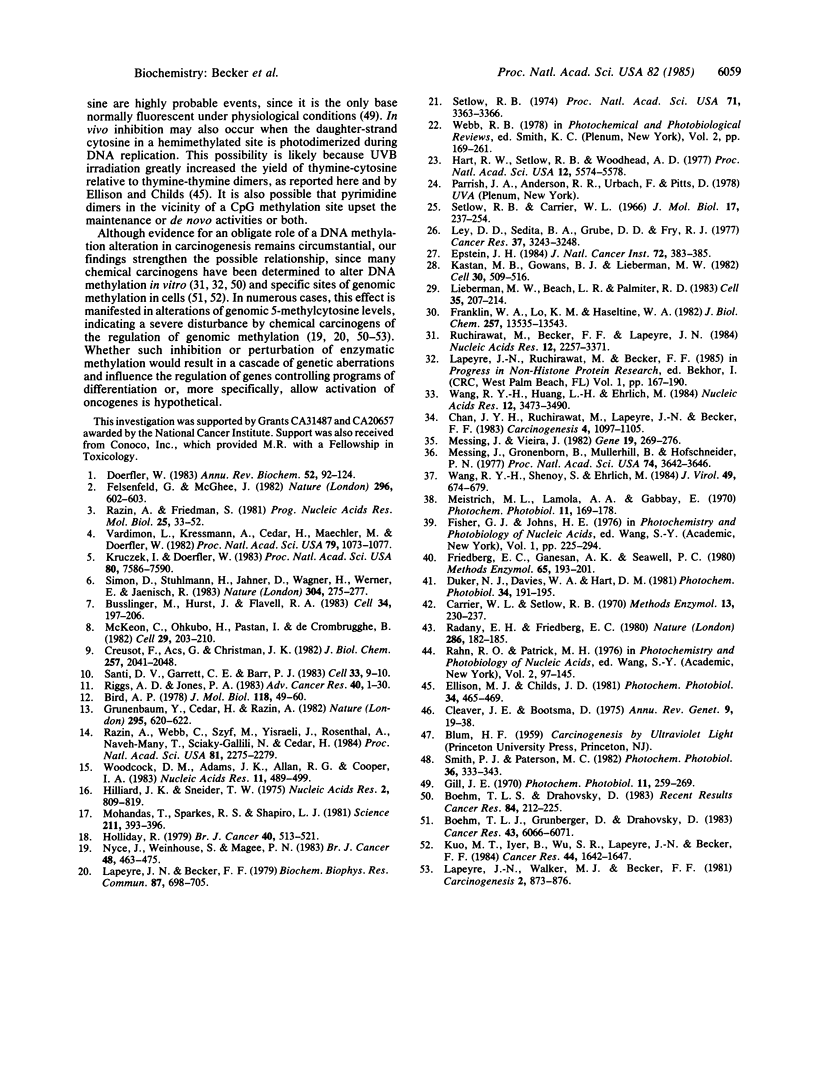
Images in this article
Selected References
These references are in PubMed. This may not be the complete list of references from this article.
- Bird A. P. Use of restriction enzymes to study eukaryotic DNA methylation: II. The symmetry of methylated sites supports semi-conservative copying of the methylation pattern. J Mol Biol. 1978 Jan 5;118(1):49–60. doi: 10.1016/0022-2836(78)90243-7. [DOI] [PubMed] [Google Scholar]
- Boehm T. L., Drahovsky D. Alteration of enzymatic DNA methylation by chemical carcinogens. Recent Results Cancer Res. 1983;84:212–225. doi: 10.1007/978-3-642-81947-6_16. [DOI] [PubMed] [Google Scholar]
- Boehm T. L., Grunberger D., Drahovsky D. Aberrant de novo methylation of DNA after treatment of murine cells with N-acetoxy-N-2-acetylaminofluorene. Cancer Res. 1983 Dec;43(12 Pt 1):6066–6071. [PubMed] [Google Scholar]
- Busslinger M., Hurst J., Flavell R. A. DNA methylation and the regulation of globin gene expression. Cell. 1983 Aug;34(1):197–206. doi: 10.1016/0092-8674(83)90150-2. [DOI] [PubMed] [Google Scholar]
- Chan J. Y., Ruchirawat M., Lapeyre J. N., Becker F. F. The protective role of thiol reducing agents in the in vitro inhibition of rat liver DNA methylase by direct acting carcinogens. Carcinogenesis. 1983 Sep;4(9):1097–1100. doi: 10.1093/carcin/4.9.1097. [DOI] [PubMed] [Google Scholar]
- Cleaver J. E., Bootsma D. Xeroderma pigmentosum: biochemical and genetic characteristics. Annu Rev Genet. 1975;9:19–38. doi: 10.1146/annurev.ge.09.120175.000315. [DOI] [PubMed] [Google Scholar]
- Creusot F., Acs G., Christman J. K. Inhibition of DNA methyltransferase and induction of Friend erythroleukemia cell differentiation by 5-azacytidine and 5-aza-2'-deoxycytidine. J Biol Chem. 1982 Feb 25;257(4):2041–2048. [PubMed] [Google Scholar]
- Doerfler W. DNA methylation and gene activity. Annu Rev Biochem. 1983;52:93–124. doi: 10.1146/annurev.bi.52.070183.000521. [DOI] [PubMed] [Google Scholar]
- Duker N. J., Davies W. A., Hart D. M. Alteration of uracil-DNA glycosylase activity by uracil dimers in DNA. Photochem Photobiol. 1981 Aug;34(2):191–195. [PubMed] [Google Scholar]
- Ellison M. J., Childs J. D. Pyrimidine dimers induced in Escherichia coli DNA by ultraviolet radiation present in sunlight. Photochem Photobiol. 1981 Oct;34(4):465–469. [PubMed] [Google Scholar]
- Epstein J. H. Effects of mechlorethamine (HN2, nitrogen mustard) on UV-induced carcinogenesis in hairless mouse skin. J Natl Cancer Inst. 1984 Feb;72(2):383–385. [PubMed] [Google Scholar]
- Felsenfeld G., McGhee J. Methylation and gene control. Nature. 1982 Apr 15;296(5858):602–603. doi: 10.1038/296602a0. [DOI] [PubMed] [Google Scholar]
- Franklin W. A., Lo K. M., Haseltine W. A. Alkaline lability of fluorescent photoproducts produced in ultraviolet light-irradiated DNA. J Biol Chem. 1982 Nov 25;257(22):13535–13543. [PubMed] [Google Scholar]
- Friedberg E. C., Ganesan A. K., Seawell P. C. Purification and properties of a pyrimidine dimer-specific endonuclease from E. coli infected with bacteriophage T4. Methods Enzymol. 1980;65(1):191–201. doi: 10.1016/s0076-6879(80)65027-7. [DOI] [PubMed] [Google Scholar]
- Gill J. E. Fluorescence of 5-methylcytosine. Photochem Photobiol. 1970 Apr;11(4):259–269. doi: 10.1111/j.1751-1097.1970.tb05994.x. [DOI] [PubMed] [Google Scholar]
- Gruenbaum Y., Cedar H., Razin A. Substrate and sequence specificity of a eukaryotic DNA methylase. Nature. 1982 Feb 18;295(5850):620–622. doi: 10.1038/295620a0. [DOI] [PubMed] [Google Scholar]
- Hart R. W., Setlow R. B., Woodhead A. D. Evidence that pyrimidine dimers in DNA can give rise to tumors. Proc Natl Acad Sci U S A. 1977 Dec;74(12):5574–5578. doi: 10.1073/pnas.74.12.5574. [DOI] [PMC free article] [PubMed] [Google Scholar]
- Hilliard J. K., Sneider T. W. Repair methylation of parental DNA in synchronized cultures of Novikoff hepatoma cells. Nucleic Acids Res. 1975 Jun;2(6):809–819. doi: 10.1093/nar/2.6.809. [DOI] [PMC free article] [PubMed] [Google Scholar]
- Holliday R. A new theory of carcinogenesis. Br J Cancer. 1979 Oct;40(4):513–522. doi: 10.1038/bjc.1979.216. [DOI] [PMC free article] [PubMed] [Google Scholar]
- Kastan M. B., Gowans B. J., Lieberman M. W. Methylation of deoxycytidine incorporated by excision-repair synthesis of DNA. Cell. 1982 Sep;30(2):509–516. doi: 10.1016/0092-8674(82)90248-3. [DOI] [PubMed] [Google Scholar]
- Kruczek I., Doerfler W. Expression of the chloramphenicol acetyltransferase gene in mammalian cells under the control of adenovirus type 12 promoters: effect of promoter methylation on gene expression. Proc Natl Acad Sci U S A. 1983 Dec;80(24):7586–7590. doi: 10.1073/pnas.80.24.7586. [DOI] [PMC free article] [PubMed] [Google Scholar]
- Kuo M. T., Iyer B., Wu J. R., Lapeyre J. N., Becker F. F. Methylation of the alpha-fetoprotein gene in productive and nonproductive rat hepatocellular carcinomas. Cancer Res. 1984 Apr;44(4):1642–1647. [PubMed] [Google Scholar]
- Lapeyre J. N., Becker F. F. 5-Methylcytosine content of nuclear DNA during chemical hepatocarcinogenesis and in carcinomas which result. Biochem Biophys Res Commun. 1979 Apr 13;87(3):698–705. doi: 10.1016/0006-291x(79)92015-1. [DOI] [PubMed] [Google Scholar]
- Lapeyre J. N., Walker M. S., Becker F. F. DNA methylation and methylase levels in normal and malignant mouse hepatic tissues. Carcinogenesis. 1981;2(9):873–878. doi: 10.1093/carcin/2.9.873. [DOI] [PubMed] [Google Scholar]
- Ley R. D., Sedita A., Grube D. D., Fry R. J. Induction and persistence of pyrimidine dimers in the epidermal DNA of two strains of hairless mice. Cancer Res. 1977 Sep;37(9):3243–3248. [PubMed] [Google Scholar]
- Lieberman M. W., Beach L. R., Palmiter R. D. Ultraviolet radiation-induced metallothionein-I gene activation is associated with extensive DNA demethylation. Cell. 1983 Nov;35(1):207–214. doi: 10.1016/0092-8674(83)90223-4. [DOI] [PubMed] [Google Scholar]
- McKeon C., Ohkubo H., Pastan I., de Crombrugghe B. Unusual methylation pattern of the alpha 2 (l) collagen gene. Cell. 1982 May;29(1):203–210. doi: 10.1016/0092-8674(82)90104-0. [DOI] [PubMed] [Google Scholar]
- Meistrich M. L., Lamola A. A., Gabbay E. Sensitized photoinactivation of bacteriophage T4. Photochem Photobiol. 1970 Mar;11(3):169–178. doi: 10.1111/j.1751-1097.1970.tb05985.x. [DOI] [PubMed] [Google Scholar]
- Messing J., Gronenborn B., Müller-Hill B., Hans Hopschneider P. Filamentous coliphage M13 as a cloning vehicle: insertion of a HindII fragment of the lac regulatory region in M13 replicative form in vitro. Proc Natl Acad Sci U S A. 1977 Sep;74(9):3642–3646. doi: 10.1073/pnas.74.9.3642. [DOI] [PMC free article] [PubMed] [Google Scholar]
- Messing J., Vieira J. A new pair of M13 vectors for selecting either DNA strand of double-digest restriction fragments. Gene. 1982 Oct;19(3):269–276. doi: 10.1016/0378-1119(82)90016-6. [DOI] [PubMed] [Google Scholar]
- Mohandas T., Sparkes R. S., Shapiro L. J. Reactivation of an inactive human X chromosome: evidence for X inactivation by DNA methylation. Science. 1981 Jan 23;211(4480):393–396. doi: 10.1126/science.6164095. [DOI] [PubMed] [Google Scholar]
- Nyce J., Weinhouse S., Magee P. N. 5-Methylcytosine depletion during tumour development: an extension of the miscoding concept. Br J Cancer. 1983 Oct;48(4):463–475. doi: 10.1038/bjc.1983.219. [DOI] [PMC free article] [PubMed] [Google Scholar]
- Radany E. H., Friedberg E. C. A pyrimidine dimer-DNA glycosylase activity associated with the v gene product of bacterophage T4. Nature. 1980 Jul 10;286(5769):182–185. doi: 10.1038/286182a0. [DOI] [PubMed] [Google Scholar]
- Razin A., Friedman J. DNA methylation and its possible biological roles. Prog Nucleic Acid Res Mol Biol. 1981;25:33–52. doi: 10.1016/s0079-6603(08)60482-1. [DOI] [PubMed] [Google Scholar]
- Razin A., Webb C., Szyf M., Yisraeli J., Rosenthal A., Naveh-Many T., Sciaky-Gallili N., Cedar H. Variations in DNA methylation during mouse cell differentiation in vivo and in vitro. Proc Natl Acad Sci U S A. 1984 Apr;81(8):2275–2279. doi: 10.1073/pnas.81.8.2275. [DOI] [PMC free article] [PubMed] [Google Scholar]
- Riggs A. D., Jones P. A. 5-methylcytosine, gene regulation, and cancer. Adv Cancer Res. 1983;40:1–30. doi: 10.1016/s0065-230x(08)60678-8. [DOI] [PubMed] [Google Scholar]
- Santi D. V., Garrett C. E., Barr P. J. On the mechanism of inhibition of DNA-cytosine methyltransferases by cytosine analogs. Cell. 1983 May;33(1):9–10. doi: 10.1016/0092-8674(83)90327-6. [DOI] [PubMed] [Google Scholar]
- Setlow R. B., Carrier W. L. Pyrimidine dimers in ultraviolet-irradiated DNA's. J Mol Biol. 1966 May;17(1):237–254. doi: 10.1016/s0022-2836(66)80105-5. [DOI] [PubMed] [Google Scholar]
- Setlow R. B. The wavelengths in sunlight effective in producing skin cancer: a theoretical analysis. Proc Natl Acad Sci U S A. 1974 Sep;71(9):3363–3366. doi: 10.1073/pnas.71.9.3363. [DOI] [PMC free article] [PubMed] [Google Scholar]
- Simon D., Stuhlmann H., Jähner D., Wagner H., Werner E., Jaenisch R. Retrovirus genomes methylated by mammalian but not bacterial methylase are non-infectious. Nature. 1983 Jul 21;304(5923):275–277. doi: 10.1038/304275a0. [DOI] [PubMed] [Google Scholar]
- Smith P. J., Paterson M. C. Lethality and the induction and repair of DNA damage in far, mid or near UV-irradiated human fibroblasts: comparison of effects in normal, xeroderma pigmentosum and Bloom's syndrome cells. Photochem Photobiol. 1982 Sep;36(3):333–343. doi: 10.1111/j.1751-1097.1982.tb04383.x. [DOI] [PubMed] [Google Scholar]
- Vardimon L., Kressmann A., Cedar H., Maechler M., Doerfler W. Expression of a cloned adenovirus gene is inhibited by in vitro methylation. Proc Natl Acad Sci U S A. 1982 Feb;79(4):1073–1077. doi: 10.1073/pnas.79.4.1073. [DOI] [PMC free article] [PubMed] [Google Scholar]
- Wang R. Y., Huang L. H., Ehrlich M. Human placental DNA methyltransferase: DNA substrate and DNA binding specificity. Nucleic Acids Res. 1984 Apr 25;12(8):3473–3490. doi: 10.1093/nar/12.8.3473. [DOI] [PMC free article] [PubMed] [Google Scholar]
- Wang R. Y., Shenoy S., Ehrlich M. DNA methylation inhibits the transfecting activity of replicative- form phi X174 DNA. J Virol. 1984 Mar;49(3):674–679. doi: 10.1128/jvi.49.3.674-679.1984. [DOI] [PMC free article] [PubMed] [Google Scholar]
- Woodcock D. M., Adams J. K., Allan R. G., Cooper I. A. Effect of several inhibitors of enzymatic DNA methylation on the in vivo methylation of different classes of DNA sequences in a cultured human cell line. Nucleic Acids Res. 1983 Jan 25;11(2):489–499. doi: 10.1093/nar/11.2.489. [DOI] [PMC free article] [PubMed] [Google Scholar]




